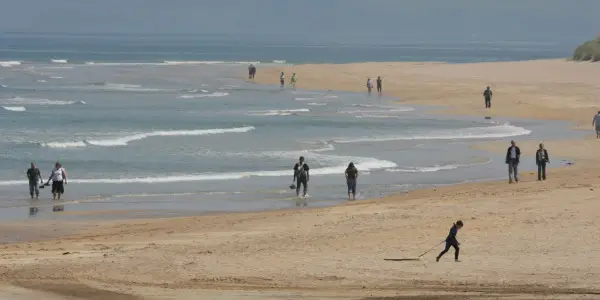Six of Ireland’s popular bathing spots failed minimum clean water tests leaving swimmers with a one in 10 risk of picking up a vomiting bug, inspectors have revealed.
While 101 of the country’s top swimming locations were classed as pristine last year, popular beaches on the Irish Sea and Atlantic coasts fell into the lowest grade on the charts.
The Environmental Protection Agency (EPA) said the worst swimming spots were the Front Strand at Youghal in Cork, Duncannon in Wexford, Rush South beach and Loughshinny in North Dublin, Ballyloughane in Galway and Merrion Strand in South Dublin.
It said last summer’s July storms played a part in the poor results in some locations.
But the agency also said that around three quarters of the country’s bathing waters appear to be relatively unaffected by pollution brought on by the weather.
Dr Matt Crowe, director of the EPA’s office of evidence and assessment, said Youghal, Duncannon, Rush and Ballyloughane were showing improvements but past results from 2012-14 kept them in the lowest grade.
“The relevant local authorities, in conjunction with Irish Water, have management plans in place to tackle the main pollution risks at these beaches, and these plans are designed to return these beaches to at least sufficient quality in the next year or two,” he said.
The EPA also noted the improving standards in Clifden, Co Galway and Lilliput on Lough Ennell in Co Westmeath.
Historically these popular swimming spots have been plagued by sewerage pollution but with a new treatment plant in place in Clifden the water quality was found to be excellent last year. In Lilliput wastewater is now being pumped to a new location until a permanent solution can be found.
The EPA said similar improving results are expected for Duncannon and Youghal this year.
Two beaches in the Dublin area saw a drop in standards for different reasons – Merrion Strand and Loughshinny.
The EPA said the issues in Merrion were complex and had been developing for years, with the water running out of the Elm Park stream one issue and the growing numbers of seabirds another.
Loughshinny got its poor mark partly due to quality issues overall during the bathing season.
Peter Webster, EPA senior scientific officer, said: “The fact that any bathing water has been classified as poor means that there is a risk of periodic microbiological pollution.
“Under the Bathing Water Regulations, local authorities are required to put in place notifications for the entire bathing season advising the public against bathing which could include a bathing prohibition if a serious pollution incident occurs.”
The EPA report found:
:: 147 water quality notifications were received last year and only five showed any evidence of pollution.
:: 29 bathing waters were affected by restrictions compared to just 15 in 2014 though most of these were short-term issues.
:: Seven notifications related to sewerage, three were suspected pollution from farms and three from septic tanks.
:: Inspectors imposed bathing restrictions on beaches and swimming spots on 131 days.
